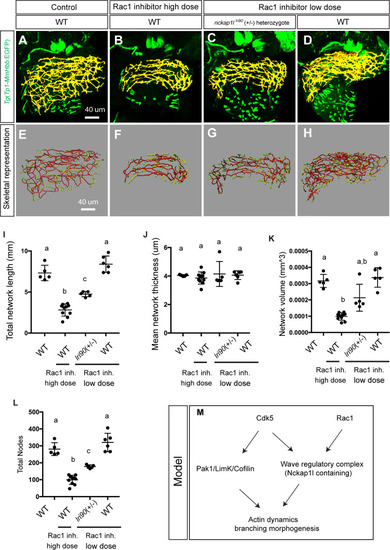|
<italic>nckap1l</italic> dosage-dependent sensitization to Rac1 inhibitor treatment suggests that Nckap1l acts downstream of Rac1 to regulate intrahepatic biliary network branching morphogenesis.Wild-type and heterozygous nckap1llri90 mutant larvae were treated with either high dose (50 ug/ml) or low dose (10 ug/ml) Rac1 inhibitor from 3 to 5 dpf, and then the treated larvae were analyzed at 5 dpf. (A-D) Projected confocal images of Tg(Tp1-MmHbb:EGFP)um14 expression in control wild-type (A), high dose (50 ug/ml) Rac1 inhibitor-treated wild-type (B), low dose (10 ug/ml) Rac1 inhibitor-treated heterozygous nckap1llri90 mutant (C), and low dose (10 ug/ml) Rac1 inhibitor-treated wild-type (D) larvae at 5 dpf. GFP expression in the intrahepatic biliary network is shown in pseudocolored yellow. (E-H) Skeletal representation of the intrahepatic biliary network in wild-type (E), 50 ug/ml Rac1 inhibitor-treated wild-type (F), 10 ug/ml Rac1 inhibitor-treated heterozygous nckap1llri90 mutant (G), and 10 ug/ml Rac1 inhibitor-treated wild-type (H) larvae computed based on Tg(Tp1-MmHbb:EGFP)um14 expression at 5 dpf. The end points (green), nodes (white), node-node connections (red), and node-end point connections (yellow) are colored separately. Ventral views, anterior to the top. (I-L) Computational analysis-based measurements of the intrahepatic biliary network structures of wild-type, high dose (50 ug/ml) Rac1 inhibitor-treated wild-type, low dose (10 ug/ml) Rac1 inhibitor-treated heterozygous nckap1llri90 mutant, and low dose (10 ug/ml) Rac1 inhibitor-treated wild-type larvae at 5 dpf. (I) Total network length of the intrahepatic biliary network. (J) Mean network thickness of the intrahepatic network. (K) Network volume (mm3) of the intrahepatic biliary network. (L) Total number of nodes in the intrahepatic biliary network. These data together indicate that low dose (10 ug/ml) Rac1 inhibitor treatment did not cause any observable phenotype in the intrahepatic biliary network of wild-type larvae, but losing one copy of the nckap1l gene significantly enhanced the effect of low dose (10 ug/ml) Rac1 inhibitor treatment and induced a phenotype to closer to that of high dose (50 ug/ml) Rac1 inhibitor treated wild-type larvae. These data suggest that nckap1l acts downstream of Rac1 to regulate intrahepatic biliary network branching morphogenesis. Plots with a shared letter indicate that the difference is not statistically significant. (M) Model of the Cdk5-mediated kinase cascade that regulates branching morphogenesis of the intrahepatic biliary network. We have previously shown that Cdk5 regulates the Pak1/Limk1/Cofilin kinase cascade to regulate actin dynamics. The current study revealed that Cdk5 also regulates the WAVE regulatory complex to regulate branching morphogenesis of the intrahepatic biliary network. In this process, a previously unannotated minor splice isoform of Nckap1l appears to be important to form a functional WAVE regulatory complex in biliary epithelial cells.
|

